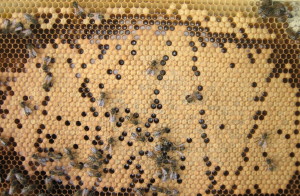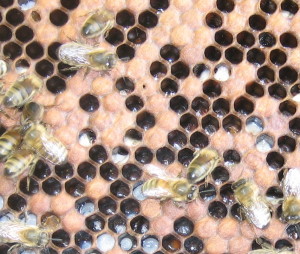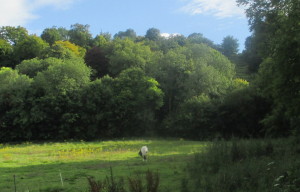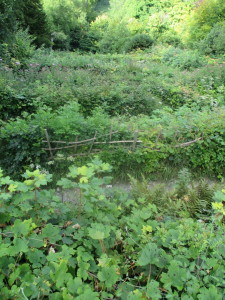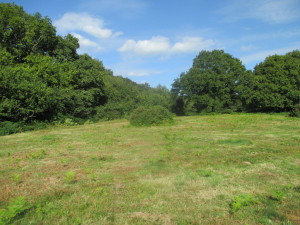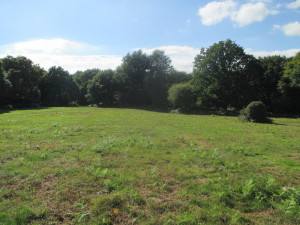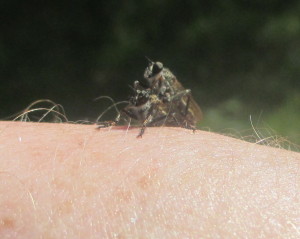Blog – bees, beekeeping & other sticky subjects
A tale of two colonies
Two colonies side-by-side in one apiary display rather different brood patterns.
One (left) is healthy with empty cells only where the foundation wiring is, the other (right) has very pepper-pot like brood with some larvae looking suspiciously like foulbrood. It isn’t actually foulbrood, but the result of PMS: Parasitic Mite Syndrome. (Here’s a really good comprehensive look at PMS.) It’s Varroa doing its worst! the one on the left has Varroa too, but is managing much better.
One big difference: the colony on the left was swarm managed back in May and now has a new queen. The one on the right has had the same queen all season and therefore hasn’t had a brood break that might help curb the growth of the Varroa mite population.
Both are now being treated with Apiguard. The one on the right is expected to recover even from its very poorly state which only became evident after the summer flow finished.
Turlough
Vita’s Guest Beekeeper Blogger
Rediscovering the first recorded Drone Congregation Area
Turlough, Vita’s Blogger, has gone in search of the first recorded Drone Congregation Area:
The first documented record of a Drone Congregation Area (DCA), where drones assemble in the hope of mating with a honeybee queen, was by the eighteenth century naturalist Gilbert White. He heard a buzzing noise on Selborne Common in Hampshire, England but had no idea what it was:
Humming in the Air
There is a natural occurrence to be met with upon the highest part of our down in hot summer days, which always amuses me much, without giving me any satisfaction with respect to the cause of it; and that is a loud audible humming of bees in the air, though not one insect is to be seen. This sound is to be heard distinctly the whole common through, from the Moneydells, to Mr White’s avenue-gate. Any person would suppose that a large swarm of bees was in motion, & playing about over his head. This noise was heard last week on June 28th.
Gilbert White in A Natural History of Selborne in the late 1700s
Beowulf Cooper says he found it in 1973, but didn’t give a precise location. Phil, a blogger, went in search of it in 2012, but didn’t succeed in locating it.
Yesterday, I went in search of the Selborne DCA and met with success, though not quite as dramatic as Gilbert White’s experience.
Selborne Common is on a 200 metre high Greensand plateau on the edge of chalk country. The best way to reach it is up the beautifully conserved Zig-Zag path first created by Gilbert White and his brother in 1753.
Selborne Common today is quite heavily wooded with many beech trees and some small clearings. In White’s day it is likely to have been less wooded and more open mainly because of the many sheep that grazed there.
Armed with my extra-long fishing rod and queen lure, it wasn’t going to be possible to get above the trees to test for the DCA, so I headed for the various clearings in the woodland. The clearings are mostly quite small except for one of about two or three hectares on Sheep Down – and that is almost the highest point of the Common where White says he heard the buzzing.
The clearings on the side showed up nothing, but in a small clearing just before Sheep Down two drones were attracted to the lure.
On Sheep Down the presence of drones was unmistakable with the lure. In fact I was hit on the head a few times by wayward drones, an indignity which I don’t think White suffered.
The Selborne DCA has significant differences to the others I have discovered especially because it is enclosed by trees. But altitude and exposure to the breeze fitted the pattern.
Yesterday, the number of drones attracted to the lure was quite small (not nearly as many as in the image below), but then August is late in the honeybee season and many drones have now been expelled from colonies that are ‘queen-right’ and beginning to prepare for winter after the end of the summer honey flow.
Finally, here is the sound from late yesterday afternoon. What Gilbert White heard in the 18th century was obviously much louder. Perhaps there were more bees back then and no twentieth century intrusive noises. Also, he dates his experience to the end of June when there is likely to be much more drone activity. Next June is already marked in my diary.
For the story of the DCA searches so far:
1 July 2015 In search of a mate
2 July 2015 Drone Congregation Areas
7 July 2015 Another Drone Congregation Area
20 July 2015 Video of Life in a Drone Congregation Area
28 July 2015 Do drones assemble above prehistoric sites?
3 August 2015 Drone Goal?
10 August 2015 Rediscovering the first recorded Drone Congregation Area
8 September 2015 In search of a Drone Congregation Area SatNav
27 October 2015 Hilltopping
Tailpiece: it’s not just a honeybee mating area. This pair landed on my arm:
Turlough
Vita’s Guest Beekeeper blogger
Drone Goal?
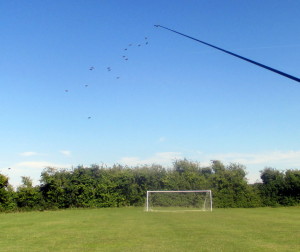 I bet the village footballers don’t know, but they play underneath a Drone Congregation Area, those secretive places that honeybee queens and drones meet to mate.
I bet the village footballers don’t know, but they play underneath a Drone Congregation Area, those secretive places that honeybee queens and drones meet to mate.
I had a hunch that the village recreation ground might be a suitable site, but was disappointed at first that no drones were chasing the queen lure on the end of the fishing rod.
But after a while, they arrived and wouldn’t leave.
I suspect that they lie in wait somewhere (in this case maybe the substitutes’ bench) waiting for a pheromone or other stimulus before raising themselves into action. It happens on almost every site — a short, but definite delay, before the drones leap into action.
So far I’ve located six Drone Congregation Areas — each about one or two kilometres apart. The mapping has begun, but I fear the drone season may be closing in.
The story so far:
1 July 2015 In search of a mate
2 July 2015 Drone Congregation Areas
7 July 2015 Another Drone Congregation Area
20 July 2015 Video of Life in a Drone Congregation Area
28 July 2015 Do drones assemble above prehistoric sites?
Turlough
Vita’s Guest Beekeeper Blogger
Do drones assemble above prehistoric sites?
Vita’s Blogger is continuing the search for Drone Congregation Areas (DCAs) and a fourth has turned up provoking an intriguing thought: could there be a connection between the location of DCAs and prehistoric monuments?
To recap: drones congregate in specific places to meet and mate with honeybee queens. No-one can consistently describe the areas nor predict where they might be. It’s all a bit of a mystery. Do the drones and queens locate these areas by smell, sight, hearing, air movements or something altogether different? Even the density of DCAs in a given area is subject to debate.
Having found a lively DCA close to the steep scarp slope of chalk downland (chalk landscapes often have a steep scarp slope in one direction and a more gentle dip slope in the other), I decided to venture along the scarp slope to see if there was another. The first one had been in the general vicinity of two mapped prehistoric barrows (ancient burial sites, often dating back 2000 years and more).
There was another. And even though the temperature was relatively cool (just above 20C), the drones were out in force. Here’s a video of them in action and showing the general location. In fact the drones were videoed just above the centre of a prehistoric bell barrow.
Karl Showler, well-known British beekeeper and author, has suggested that there could be a link between prehistoric sites and DCAs. He has wondered if prehistoric man was in awe of the buzzing sounds from unseen objects above their heads in certain locations. Perhaps they thought it was made by the gods and decided to build their special memorials beneath them. (We should remember that today we may not be sensitized to such sounds because of air and road vehicle noises and the noise is less because there are probably fewer honeybees since Varroa has arrived.)
However, there could be other explanations of the association between barrows and bees — if indeed there is an association at all. Prehistoric man often constructed barrows partly to mark the edge of their territories and often that might be just be below a ridge in the landscape. Drones might be attracted to these areas for other reasons, such as wind direction and air currents.
Beowulf Cooper suggested that drones like to operate in areas of warmed and rising air. It’s just possible that the disturbance of areas where barrows have been built create areas of warm updrafts. I think that might be fanciful, however, because the DCA stretched with some intensity quite some distance beyond the barrow.
Nonetheless, Karl Showler has raised an intriguing possibility of a link, deliberate or otherwise, between prehistoric man and honeybees. But there are other ideas too and nothing quite seems to suit all situations. Are we missing a critical factor that would explain all?
Next up: a DCA on a village recreation ground.
Turlough
Vita’s Guest Beekeeper Blogger
Video of life in a Drone Congregation Area
Here’s a video of life in a Drone Congregation Area. This was my third outing to find a honeybee drone assembly and to my amazement, this third find is the best yet.
About thirty drones can be seen pursuing a caged and mated Queen in one of those special areas where Queens go to mate. This caged Queen actually mated last year and I had just caught her in a swarm, but she is still of great interest to these frisky drones. For the full story, see the links below.
You can read the stories so far of the search for Drone Congregation Areas here:
1 July 2015 In search of a mate
2 July 2015 Drone Congregation Areas
7 July 2015 Another Drone Congregation Area
20 July 2015 Video of Life in a Drone Congregation Area
28 July 2015 Do drones assemble above prehistoric sites?
3 August 2015 Drone Goal
Turlough
Vita’s Guest Beekeeper Blogger

